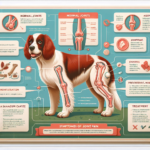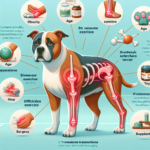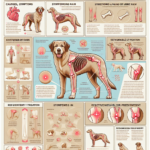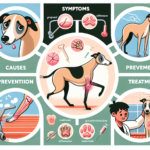Welsh Springer Spaniel Joint Pain: Causes, Symptoms, Prevention, and Treatment

Introduction
The Welsh Springer Spaniel is a breed known for its distinctive red and white coat, friendly demeanor, and boundless energy. Originating from Wales, this breed has a rich history as a hunting dog, particularly skilled in flushing game from dense underbrush. With a medium build, the Welsh Springer Spaniel is both agile and robust, making it a favorite among hunters and families alike. Despite their generally healthy disposition, Welsh Springer Spaniels are prone to certain health issues, with joint pain being a significant concern.
Joint health is crucial for the Welsh Springer Spaniel due to their active lifestyle and working heritage. Joint pain can severely impact their quality of life, limiting their mobility and causing significant discomfort. Understanding the causes, symptoms, prevention, and treatment of joint pain in Welsh Springer Spaniels is essential for ensuring their well-being and longevity.
Breed-Specific Joint Pain Risks
Genetic Predisposition
Like many purebred dogs, Welsh Springer Spaniels have a genetic predisposition to certain joint-related issues. Hip dysplasia, a condition where the hip joint doesn’t fit properly into the hip socket, is relatively common in this breed. Elbow dysplasia, where the elbow joint is malformed, can also occur. Both conditions can lead to arthritis, a painful inflammation of the joints that worsens over time.
Age-Related Risks
As Welsh Springer Spaniels age, the risk of developing joint pain increases. Typically, signs of joint issues may start to appear in middle age, around 5 to 7 years old. However, some dogs may show symptoms earlier, especially if they have a genetic predisposition or have experienced joint injuries.
Activity Level and Joint Stress
Welsh Springer Spaniels are known for their high energy levels and love for physical activity. Whether they are working as hunting dogs or participating in agility sports, their joints are subjected to significant stress. Repetitive high-impact activities can exacerbate joint wear and tear, leading to conditions like arthritis.
Common Symptoms of Joint Pain in Welsh Springer Spaniels
General Symptoms
- Limping: One of the most noticeable signs of joint pain is limping or favoring one leg over another.
- Stiffness: Dogs may show stiffness, especially after resting or sleeping.
- Reluctance to Move: A dog in pain may be hesitant to run, jump, or climb stairs.
- Swelling: Joints may appear swollen or feel warm to the touch.
- Behavioral Changes: Irritability or changes in behavior can also indicate discomfort.
Breed-Specific Symptoms
In Welsh Springer Spaniels, joint pain may manifest as a reluctance to engage in activities they once enjoyed, such as hunting or playing fetch. They may also show a decreased range of motion in their limbs, making it difficult for them to perform tasks that require agility and flexibility.
When to Consult a Vet
If you notice any of the above symptoms in your Welsh Springer Spaniel, it is crucial to consult a veterinarian. Early diagnosis and treatment can significantly improve the quality of life for dogs suffering from joint pain. Persistent limping, noticeable swelling, or severe reluctance to move should prompt an immediate veterinary visit.
Preventive Measures for Joint Health
Exercise Recommendations
Regular, moderate exercise is essential for maintaining joint health in Welsh Springer Spaniels. Activities like swimming, which is low-impact, can be particularly beneficial. Avoid high-impact exercises like excessive running on hard surfaces, which can exacerbate joint wear and tear. Instead, opt for controlled activities that build muscle strength without overloading the joints.
Dietary Suggestions
A balanced diet rich in essential nutrients can support joint health. Foods high in omega-3 fatty acids, such as fish oil, can reduce inflammation. Supplements like glucosamine and chondroitin can also promote joint health by supporting cartilage repair and reducing pain. Always consult your veterinarian before adding supplements to your dog’s diet.
Weight Management
Maintaining a healthy weight is crucial for reducing joint stress. Overweight dogs are at a higher risk of developing joint issues due to the extra load on their joints. Regularly monitor your Welsh Springer Spaniel’s weight and adjust their diet and exercise routine as needed to keep them within a healthy weight range.
Early Screening and Monitoring
Early screening for joint issues can help catch problems before they become severe. Regular veterinary check-ups should include joint assessments, especially as your dog ages. X-rays and other diagnostic tools can help identify early signs of joint problems, allowing for timely intervention.
Treatment Options for Joint Pain
Non-Surgical Treatments
Non-surgical treatments for joint pain include medications like non-steroidal anti-inflammatory drugs (NSAIDs) to reduce pain and inflammation. Physical therapy can also be beneficial, helping to strengthen the muscles around the joints and improve mobility. Lifestyle adjustments, such as providing a comfortable bed and avoiding slippery floors, can also make a significant difference.
Surgical Options
In severe cases, surgical intervention may be necessary. Common surgeries for joint pain include hip replacement, arthroscopy to remove damaged tissue, and osteotomy to realign bones. These procedures can be highly effective but come with risks and require a significant recovery period.
Alternative Therapies
Alternative treatments like acupuncture, hydrotherapy, and massage can also provide relief for dogs with joint pain. Acupuncture can help reduce pain and inflammation, while hydrotherapy offers low-impact exercise that strengthens muscles without stressing the joints. Massage can improve circulation and reduce muscle tension, providing additional comfort.
Lifestyle and Management Tips
Daily Care Routine
A daily care routine for a Welsh Springer Spaniel with joint pain should include gentle exercise, a balanced diet, and regular monitoring of their condition. Short, frequent walks are better than long, strenuous ones. Incorporate joint-friendly activities like swimming and ensure they have a comfortable place to rest.
Modifying the Home Environment
Making your home more comfortable for a dog with joint pain can significantly improve their quality of life. Consider installing ramps to help them navigate stairs and providing orthopedic beds to support their joints. Non-slip mats can also prevent falls on slippery surfaces.
Long-Term Management
Long-term management of joint pain involves regular veterinary check-ups, ongoing weight management, and consistent use of any prescribed medications or supplements. Keeping your dog active and engaged with joint-friendly activities can help maintain their mobility and overall well-being.
FAQs About Welsh Springer Spaniels and Joint Pain
What are the early signs of joint pain in Welsh Springer Spaniels?
Early signs include limping, stiffness, reluctance to move, and behavioral changes such as irritability or decreased interest in activities they once enjoyed.
Can joint pain in Welsh Springer Spaniels be prevented?
While genetic predispositions cannot be entirely prevented, maintaining a healthy weight, providing a balanced diet, and ensuring regular, moderate exercise can significantly reduce the risk of joint pain.
Are there specific foods that can help with joint health?
Yes, foods rich in omega-3 fatty acids and supplements like glucosamine and chondroitin can support joint health. Always consult your veterinarian before making dietary changes.
When should I consider surgery for my dog’s joint pain?
Surgery should be considered when non-surgical treatments are no longer effective, and the dog’s quality of life is significantly impacted. Consult your veterinarian for a thorough evaluation and recommendation.
Conclusion
Joint pain is a significant concern for Welsh Springer Spaniels, given their active lifestyle and genetic predispositions. By understanding the causes, symptoms, prevention, and treatment options, owners can take proactive steps to ensure their dog’s joint health. Regular veterinary check-ups, a balanced diet, appropriate exercise, and weight management are crucial for preventing and managing joint pain. Early intervention and consistent care can help your Welsh Springer Spaniel live a happy, active life despite joint issues.
Remember, always consult your veterinarian for personalized advice and treatment plans tailored to your dog’s specific needs. Taking preventive measures and staying vigilant about your dog’s joint health can make a world of difference in their overall well-being.




